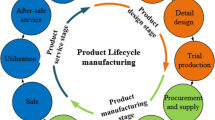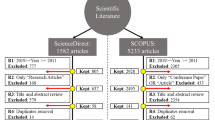Abstract
This paper presents a cost modelling system for lean product and process development to support proactive decision making and mistake elimination at the design stage. The foundations of the system are based upon three lean product and process development enablers, namely: Set-based concurrent engineering, knowledge-based engineering, and mistake proofing (Poka-yoke). The development commenced with an industrial field study of eleven leading European industries from the aerospace, automotive, telecommunication, medical and domestic appliance sectors. Based on the requirements of industrial collaborators, the developed system comprises six modules: value identification, manufacturing process/machines selection, material selection, geometric features specification, geometric features and manufacturability assessment, and manufacturing time and cost estimation. The work involved the development of a feature-based cost estimation method for the resistance spot welding process. The developed system was finally validated using an industrial case study. The developed system has the capability to provide estimates related to product cost and associated values concurrently, facilitate decision making, eliminate mistakes during the design stage, and incorporate ‘customer voice’ during a critical decision making stage.
Similar content being viewed by others
References
Al-Ashaab A, Shehab E, Alam R, Sopelana A, Sorli M, Flores M, Taisch M, Stokic D, James-Moore M (2010) "The Conceptual LeanPPD Model", Proceedings of the 17th ISPE International Conference on Concurrent Engineering, 6–10 September. Warsaw University of Technology, Cracow
Aslanlar S (2006) The effect of nucleus size on mechanical properties in electrical resistance spot welding of sheets used in automotive industry. Mater Des 27(2):125–131
Benyounis K, Olabi A, Hashmi M (2008) Multi-response optimization of CO2 laser-welding process of austenitic stainless steel. Opt Laser Tech 40(1):76–87
Bouaziz Z, Younes JB, Zghal A (2006) Cost estimation system of dies manufacturing based on the complex machining features. Int J Adv Manuf Technol 28(3):262–271
Brinke E (2002) Costing support and cost control in manufacturing. A cost estimation tool applied in the sheet metal domain. PhD Thesis, Vakgroep Ontwerpen, University of Twente
Chan DSK (2003) Expert system for product manufacturability and cost evaluation. Mater Manuf Process 18(2):313–322
Chan DSK, Lewis WP (2000) The integration of manufacturing and cost information into the engineering design process. Int J Prod Res 38(17):4413–4427
Chayoukhi S, Bouaziz Z, Zghal A (2009) COSTWELD: a cost estimation system of welding based on the feature model. Adv Prod Eng Manag 4(4):263–274
Cicconi P, Germani M, Mandolini M (2010) How to support mechanical product cost estimation in the embodiment design phase, new world situation: new directions in concurrent engineering. Springer, London, pp 419–430
Curran R, Verhagen WJC, van der Laan TH, van Tooren M (2009) "KBE and manufacturing constraints management", Global Perspective for Competitive Enterprise, Economy and Ecology, pp 783–791
Djassemi M (2008) "A computer-based economic analysis for manufacturing process selection", Proceedings of the 2008 IAJC-IJME International Conference, Nov. 2008, Nashville, Tennessee, US
Er A, Dias R (2000) A rule-based expert system approach to process selection for cast components. Knowl-Based Syst 13(4):225–234
Esawi AMK, Ashby MF (2003) Cost estimates to guide pre-selection of processes. Mater Des 24(8):605–616
Feder DK (1993) Cost implications in the design of welded steels structures. Weld World 31(4)
Feng S, Zhang Y (1999) Conceptual process planning—a definition and functional decomposition. Manuf Sci Eng, Proc 1999 Int Mech Eng Congres Expo 10(Citeseer):91–106
Jamaludin R (2008) A product-based non-conformance classification, Proceedings of the 9th Asia Pacific Industrial Engineering & Management Systems Conference (APIEMS 2008), 3rd–5th Dec, Nusa Dua, Bali, Indonesia, pp 2846–2854
Kennedy M, Harmon K, Minnock E (2008) Ready, set, dominate: Implement Toyota’s set-based learning for developing products. Oakley
Khan M, Al-Ashaab A, Doultsinou A, Shehab E, Ewers P, Sulowski R (2011) Set-based concurrent engineering process within the LeanPPD environment. Improv Complex Syst Today, Adv Concurr Eng. doi:10.1007/978-0-85729-799-0_51,pp.433-440
Khan M, Al-Ashaab A, Shehab E, Haque B, Ewers P, Sorli M, Sopelana A (2011) Towards Lean Product and Process Development, Accepted for publication in the Lean PD special issue of International Journal of Computer Integrated Manufacturing
Klansek U, Kravanja S (2006) Cost estimation, optimization and competitiveness of different composite floor systems—part 1: self-manufacturing cost estimation of composite and steel structures. J Constr Steel Res 62(5):434–448
Kremer R, Fabrizio T (2005) The lean primer-solutions for the job shop. MCS, Chelsea
Mascitelli R (2004) The lean design guidebook. Technology Perspectives, Northridge
Masmoudi F, Bouaziz Z, Hachicha W (2007) Computer-aided cost estimation of weld operations. Int J Adv Manuf Technol 33(3):298–307
Mauchand M, Siadat A, Bernard A, Perry N (2008) Proposal for tool-based method of product cost estimation during conceptual design. J Eng Des 19(2):159–172
Mital A, Desai A, Subramanian A, Mital A (2008) Product development: a structured approach to consumer product development, design, and manufacture. Butterworth-Heinemann, Oxford
Morgan JM, Liker JK (2006) The Toyota product development system: integrating people, process, and technology. Productivity, New York
Niazi A, Dai JS, Balabani S, Seneviratne L (2006) Product cost estimation: technique classification and methodology review. J Manuf Sci Eng 128(2):563–575
Ou-Yang C, Lin TS (1997) Developing an integrated framework for feature-based early manufacturing cost estimation. Int J Adv Manuf Technol 13(9):618–629
Quintana G, Ciurana J (2011) Cost estimation support tool for vertical high speed machines based on product characteristics and productivity requirements. Int J Prod Econ 134:188–195
Ravisankar V, Balasubramanian V, Muralidharan C (2006) Selection of welding process to fabricate butt joints of high strength aluminium alloys using analytic hierarchic process. Mater Des 27(5):373–380
Roy R (2003) Cost engineering: why, what and how? Decision Engineering Report Series. Cranfield University, UK
Schreve K (1997) Cost estimating welded assemblies produced in batches. University of Stellenbosch, South Africa
Shehab E, Abdalla H (2001) Manufacturing cost modelling for concurrent product development. Robot Comput Integr Manuf 17(4):341–353
Shehab E, Abdalla H (2002) A design to cost system for innovative product development. Proc Inst Mech Eng, Part B: J Eng Manuf 216(7):999–1019
Shehab E, Abdalla H (2002) An intelligent knowledge-based system for product cost modelling. Int J Adv Manuf Technol 19(1):49–65
Skarka W (2007) Application of MOKA methodology in generative model creation using CATIA. Eng Appl Artif Intel 20(5):677–690
Sobek DK, Liker JKWAC (1998) Another look at how Toyota integrates product development. Harv Bus Rev 76(4):36–49
Sobek DK, Ward AC, Liker JK (1999) Toyota’s principles of set-based concurrent engineering. Sloan Manage Rev 40(2):67–83
Stokes M (2001) Managing engineering knowledge: MOKA: methodology for knowledge based engineering applications. Professional Engineering, London
Tammineni SV, Rao AR, Scanlan JP, Reed PAS, Keane AJ (2009) A knowledge-based system for cost modelling of aircraft gas turbines. J Eng Des 20(3):289–305
Ward AC (2007) Lean product and process development. Lean Enterprises Institute, Cambridge
Ward AC, Liker JK, Cristiano JJ, Sobek DK (1995) The second Toyota paradox: how delaying decisions can make better cars faster. Sloan Manage Rev 36:43–61
Xu J, Zhai T (2008) "The small-scale resistance spot welding of refractory alloy 50Mo-50Re thin sheet", JOM Journal of the Minerals. Met Mater Soc 60(7):80–83
Ye J, Zhang B, Qi H (2009) Cost estimates to guide manufacturing of composite waved beam. Mater Des 30(3):452–458
Author information
Authors and Affiliations
Corresponding author
Rights and permissions
About this article
Cite this article
Wasim, A., Shehab, E., Abdalla, H. et al. An innovative cost modelling system to support lean product and process development. Int J Adv Manuf Technol 65, 165–181 (2013). https://doi.org/10.1007/s00170-012-4158-4
Received:
Accepted:
Published:
Issue Date:
DOI: https://doi.org/10.1007/s00170-012-4158-4




